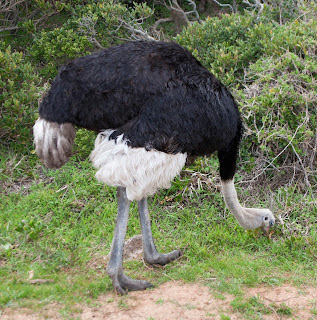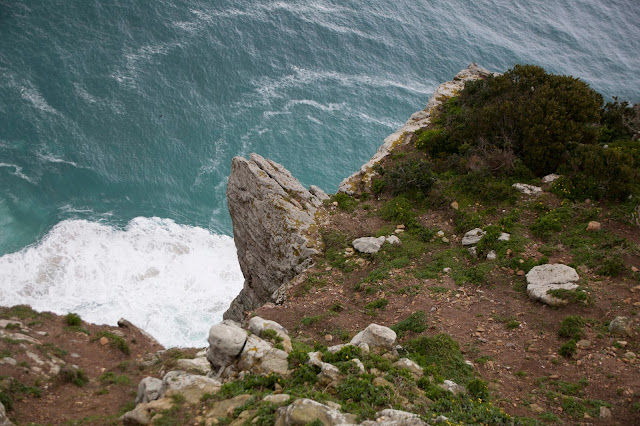Our next stop
on our morning’s adventure was the Cape of Good Hope, a rocky headland on the
Atlantic coast of the Cape Peninsula. It was overcast, but that made for some
pretty dramatic views.
 |
| It lives up to its reputation |
 |
| Where we were |
When following the western African coastline from the equator, however, the Cape of Good Hope is where a ship begins to travel more eastward than southward.
 |
| Violent seas |
the new name was also strategically designed to improve the reputation of the dangerous crossing.
The land around
the cape was home to the Khoikhoi people when the Dutch first settled there in
1652. The Khoikhoi had arrived in these parts about 1,500 years before. They
were called Hottentots by the Dutch, a term that is now considered pejorative.
in 1687, a
community of Protestant Huguenots arrived at the Cape of Good Hope from the
Netherlands, fleeing religious persecution. The Dutch East India Company needed
skilled farmers at the Cape of Good Hope and the Dutch Government saw
opportunities for the Huguenots at the Cape and sent them over. The colony
gradually grew over the next 150 years or so until it stretched for hundreds of
miles to the north and northeast.
 |
| A moody day |
The Dutch Republic
was occupied by the French and then the British in 1795, who relinquished
control of the territory in 1803; only to return and reoccupy the Cape on in
1806. The territory was ceded to the British in the Anglo-Dutch Treaty of 1814
and was thereafter administered as the Cape Colony. It remained a British
colony until being incorporated into the independent Union of South Africa in
1910 (now known as the Republic of South Africa).
 |
| Common Ostrich |
But, we
were looking at a male Common Ostrich.
The largest living species of bird, the Common Ostrich lays the largest eggs of any
living bird and has the fastest land speed of any bird.
Male Common Ostriches usually weigh from 139-320 lbs. and can stand as tall as 9 ft. 2 in., while female common ostriches can stand as tall as 6 ft. 7 in.
Male Common Ostriches usually weigh from 139-320 lbs. and can stand as tall as 9 ft. 2 in., while female common ostriches can stand as tall as 6 ft. 7 in.
Their lifespan is up to 40-45 years. And, I never realized what interesting ears Ostriches have -- kinda like earlobe gauges.
 |
| Weird ears |
Ostriches have just two toes on each foot (most birds have four), with the large nail on the larger inner toe resembling a hoof.
 |
| Lots of females |
When threatened, Ostriches run or use their legs as weapons. They are capable of killing a human or a potential predator like a Lion with a forward kick.
Ostriches lives in nomadic herds (yep, herds, not flocks) of five to 50 birds and, sure enough, across the street was a herd of young Ostriches.
Then, back across the street was a Common Eland (the only one we saw on our trip because they do not live in the parks we visited). At about five feet tall at the shoulder and up to slightly over a ton, the cow-like animal is the second largest antelope in the world, just slightly smaller than the Giant Eland. Common Elands form herds of up to 500 animals, but we saw just the one male – and he posed nicely for us. The Common Eland is used by humans for leather, meat and rich, nutritious milk. It has been domesticated in many areas.
Ostriches lives in nomadic herds (yep, herds, not flocks) of five to 50 birds and, sure enough, across the street was a herd of young Ostriches.
Then, back across the street was a Common Eland (the only one we saw on our trip because they do not live in the parks we visited). At about five feet tall at the shoulder and up to slightly over a ton, the cow-like animal is the second largest antelope in the world, just slightly smaller than the Giant Eland. Common Elands form herds of up to 500 animals, but we saw just the one male – and he posed nicely for us. The Common Eland is used by humans for leather, meat and rich, nutritious milk. It has been domesticated in many areas.
 |
| The name 'Eland' is Dutch for "Elk" or "Moose" |
The Common Eland
is the slowest antelope, with a peak speed of 25 mph that tires it quickly.
However, they can maintain a 14-mph trot indefinitely and can jump up to eight
feet from a standing start when startled.
As we drove, we
also saw a variety of birds, including the beautiful African Sacred Ibis …
 |
| Attractive birds |
 |
| Lots of them |
 |
| The Cape Fur "Seal" is actually a type of Sea Lion |
The Cape of Good Hope is also home
to Bontebok, Red Hartebeest, Grey Rhebok, Klipspringer and four (yes, four!)
Cape Mountain Zebra, plus lizards, snakes, mice, tortoises, Dassies, Water
Mongooses, Cape Clawless Otters and Fallow Deer. We didn’t see any of those –
but, then, this was just a quick drive-through.
 |
| Looking out to sea |
We stopped to take the obligatory tourist shot of our group. Everybody else was doing it, too. So, we had to negotiate some time with other tourists.The picture points out how lovely (!) the weather was. As it turns out, this is the worst weather we had for the whole trip. So, not too bad!
 |
| Caty, Kandice, Becca, Alexis, Linda, Kristen, Janet |
The picture also points out why most people have the misconception is that the Cape of Good Hope is the southern tip of Africa.
We purchased tickets to take the funicular up to the top to the Cape Point lighthouse, but, unfortunately, we had arrived just after a tour group, so we decided to walk up.
 |
| Caty and Becca; Photo: Linda Rowe |
 |
| A gorgeous bird |
But, on the way up, we encountered one of the most beautiful birds I have ever seen, a male Southern Double-collared Sunbird, which posed nicely for me to photograph it as it sang.
We didn't see any females, which are just a dull brown and grey.
Sunbirds live mainly on nectar from flowers, but also eats fruit, and, especially when feeding young, insects and spiders. They can feed on nectar by hovering like a hummingbird, but usually perch to feed.
 |
| Our first Baboons |
I had heard Baboons were dangerous, so walking right by them was unnerving. But, we were told that these guys are so habituated that they seldom cause real problems.
But they do sometimes try to
open tourist’s purses, looking for treats. Fortunately, we weren’t carrying
purses.
 |
| They are very forward |
In nearby towns people have killed many Baboons after the Baboons raid their houses looking for food. Baboons are also frequently injured or killed outside of the park by cars and by electrocution on power lines.
We took so long
photographing the Baboons that Caty and I didn’t have time to go all the way up
to the lighthouse. So, we just took some pictures from below.
And we concentrated on photographing dramatic waves
crashing against the rocks below ....
... and the Cormorant rookery on the cliffs ...
Then we took the funicular back down to our waiting
van.
As with everything we did on this day touring Cape Town, I felt that we didn't have enough time.
 |
| Cape of Good Hope Lighthouse |
 |
| Dramatic |
 |
| A closer look |
 |
| Not enough time |
I could have spent all day at Boulders Beach watching the Penguins or here at the Cape of Good Hope looking at the scenery and looking for animals -- especially those four Mountain Zebras.
Our next planned spot was the Kirstenbosch National Botanical Garden. I was thinking I would rather stay at the Cape than go see a bunch of plants. But, I was wrong on that, too. Kirstenbosch was another place I could have stayed all day.
Our next planned spot was the Kirstenbosch National Botanical Garden. I was thinking I would rather stay at the Cape than go see a bunch of plants. But, I was wrong on that, too. Kirstenbosch was another place I could have stayed all day.
Yep, Cape Town was turning out to be a very nice place. I could definitely go back!
Trip date: August 25-September 9, 2017
No comments:
Post a Comment